
“We are all alone, born alone, die alone, and—in spite of True Romance magazines—we shall all someday look back on our lives and see that, in spite of our company, we were alone the whole way. I do not say lonely—at least, not all the time—but essentially, and finally, alone. This is what makes your self-respect so important, and I don’t see how you can respect yourself if you must look in the hearts and minds of others for your happiness.”
— Hunter S. Thompson
Society shies away at the mention of loneliness. It’s a word that is bitter to the taste, tied to other words like rejection, isolation, or forgotten. For a lot of people, loneliness shows visions of silence and separation—a reminder of everything we’re scared of when we’re not surrounded by people. After all, humans are social creatures, and many of us haven’t really made peace with the idea of being alone. But what if loneliness isn’t just a void? There is something to be said about this inevitable human feeling, and in turn, it should be explored and embraced. Perhaps there is something transformative about sitting with this unknown feeling, hitting rock bottom, and finding yourself in a different light, rather than running away from it.
I didn’t come to this realization quickly or easily. After a rough breakup in my twenties—yes, it was as cliché as it sounds but nonetheless traumatizing—loneliness was all-consuming. Moving into a studio apartment on the same day I signed the lease (without even touring it first) felt daunting. Most nights, the four walls of that place felt like they were closing in on me, leaving me feeling suffocated.
During this period of my solitude, I found myself drawn to things that mirrored how I felt—movies, songs, books, and even pieces of art that captured the strange and uncomfortable quiet ache that had settled into my daily life.
One of the things I took a peculiar interest in was Edward Hopper’s Nighthawks. It’s a painting you’ve probably seen before: a quiet diner glowing softly in the middle of the night, a few cold figures scattered across its booths. It continues to be my Macbook desktop wallpaper to this day. Most people describe it as melancholic and vacant, but for me, it felt oddly comforting. The scene has a kind of balance to it—clean lines, muted colors, and a glow that contrasts with the surrounding darkness. It brings up a sense of nostalgia— an experience I can’t seem to pinpoint or perhaps a tucked-away childhood memory. Hopper somehow mastered this creative and unique perspective that is a quiet beauty, inviting reflection and resonance that feels deeply personal.
It’s not groundbreaking that many others have also found beauty in this painting rather than feeling disquieted by it. One book that came into my hands at what felt like the perfect time—given my circumstances—helped me understand this, as well as the theme explored in this article, was Olivia Laing’s book The Lonely City. She dives deep into Hopper’s work and explores the concepts of loneliness, criticizes the stigma, shares her own vulnerable story, and helps readers change their perspective to that of an empathetic one. She helped answer a lot of the questions I had: Am I the only one who is feeling this way? Obviously not. Is it okay to feel like this? Yes.
Slowly, things started to make more sense.
I started noticing this theme everywhere. Sofia Coppola’s Lost in Translation, for example, captures those quiet, in-between moments when you’re alone and so are others. Proust and Plath write about loneliness in ways that feel intimate and familiar. And then there’s music—The Velvet Underground’s After Hours played on repeat in the car, the shower, anywhere I was alone. Each of these works made me feel less alone in my loneliness like there was a shared experience that was a connection in itself.
A sanguine outcome of this experience is the birth of creativity. When someone has the chance to sit down in this primal state, and the noise of their environment goes away, their minds start to probe the ideas that are most interesting to them. They start to take in these raw emotions, make sense of them, and apply them to their understanding of their world. Many great figures have chosen to share this discovery in the form of art, and we have been able to enjoy and relate to them through different mediums. The ones who have embraced their loneliness and looked at it from a welcoming perspective have also found truth in it. You can choose to do something or nothing with this feeling, but the point is to not be completely disdained by it. Upon acceptance, will it only be possible that this experience can be used as a powerful tool.
After I understood this, I started to hold my head a little higher and threw myself into my interests and hobbies. I started reaching out to friends, developed a curiosity about the unknowns, and embraced this feeling wholly. My studio apartment mentioned before went from feeling like a psych ward to a sanctuary. That’s not to say that I didn’t still feel sad, but loneliness became my little companion that sat inside my chest and kept reminding me of my own self-assurance.
Rather than escaping, I learned that solitude is a space for self-discovery, introspection, creativity, and growth. Loneliness, though uncomfortable, can serve as a deeper understanding and connection, revealing a quiet strength and clarity that only emerges when you are able to block out the noise from the world and find comfort in isolation and in yourself.